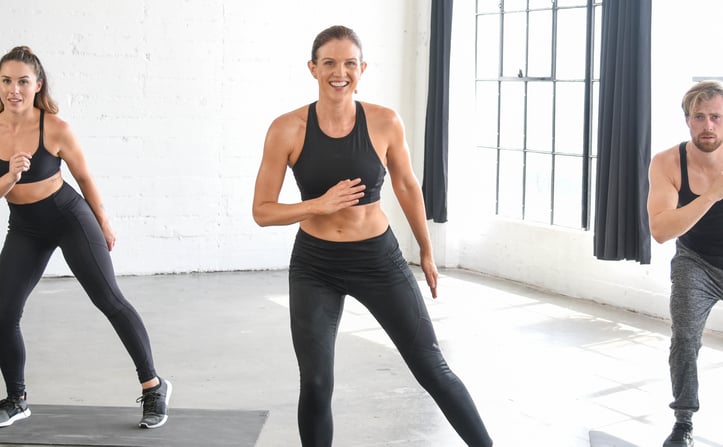
Unleash Your Fitness Potential with Kit Rich's Training Secrets
In the world of fitness, there's always something new to learn, especially when it comes to the insights from a celebrity trainer like Kit Rich. In this blog post, we'll delve deep into the training principles, offer unique perspectives, and provide practical tips for both beginners and intermediate exercisers. Let's get started!
Understanding the Training Principles
The Science of Supercompensation
Supercompensation is a fundamental concept in fitness. When you exercise, your body undergoes stress, and during the recovery period, it adapts and becomes stronger. According to the American College of Sports Medicine (ACSM), proper nutrition and rest are crucial for this process. For example, when you lift weights, your muscle fibers experience micro-tears. During recovery, the body repairs and rebuilds these fibers, making them stronger and larger. This is why it's essential to give your body enough time to recover between workouts. As a beginner, start with 2-3 strength training sessions per week, allowing at least 48 hours of rest between sessions. Intermediate exercisers can increase to 3-4 sessions per week, but still, listen to your body and adjust accordingly.
The Mechanisms of Strength Growth
Strength growth is a complex process that involves the nervous system and muscle adaptation. NASM research shows that progressive overload is key. This means gradually increasing the intensity, volume, or frequency of your workouts over time. For instance, if you're doing bicep curls with 5-pound dumbbells, as you get stronger, you can increase the weight to 8 pounds. However, it's important not to rush this process. Beginners should focus on proper form and technique before increasing the load. Intermediate exercisers can experiment with different training methods like drop sets or supersets to challenge their muscles further.
Energy System Function and Its Impact on Body Changes
Our bodies have three energy systems: the phosphagen system, the glycolytic system, and the oxidative system. Each system is responsible for different types of exercise and has a unique impact on body changes. For short, intense activities like sprinting, the phosphagen system is primarily used. For longer, moderate-intensity exercises like jogging, the oxidative system takes over. Understanding which energy system your workouts target can help you optimize your training. If your goal is to build endurance, focus on exercises that primarily use the oxidative system, such as long-distance running or cycling. For beginners, start with low-intensity aerobic exercises for 20-30 minutes, 3-4 times a week. Intermediate exercisers can increase the duration and intensity gradually.
Unique Insights
Training Adjustments for Different Body Types
Not everyone has the same body type, and it's important to adjust your training accordingly. According to NSCA research, ectomorphs (naturally thin individuals) may need to focus on increasing their calorie intake and doing more strength training to build muscle. Mesomorphs (naturally athletic individuals) can benefit from a combination of strength and cardiovascular training. Endomorphs (naturally curvy individuals) may need to pay more attention to their diet and do more high-intensity interval training (HIIT) to burn fat. For example, an ectomorph might start with a strength training routine that includes compound exercises like squats, deadlifts, and bench presses, along with a calorie-dense diet. An endomorph could try a HIIT routine that includes exercises like burpees, mountain climbers, and sprints, combined with a balanced diet that is lower in calories.
Common Mistakes in Training Movements and How to Correct Them
One of the most common mistakes in training is improper form. For example, when doing a squat, many people let their knees collapse inward or their back round. This can lead to knee and back pain, as well as reduced effectiveness of the exercise. To correct this, focus on keeping your feet shoulder-width apart, your knees in line with your toes, and your back straight. Another common mistake is not using a full range of motion. When doing bicep curls, for instance, some people only curl the weight halfway up. This limits the muscle activation and growth. To fix this, make sure to fully extend your arm at the bottom and fully curl the weight to the top. Beginners should start with lighter weights and focus on proper form, while intermediate exercisers can use heavier weights but still need to be vigilant about their technique.
Practical Training Plan
Here's a one-week training plan inspired by Kit Rich's approach:
Monday: Upper Body Strength Training
- Warm-up: 5 minutes of light jogging or jumping jacks
- Push-ups: 3 sets of 10-12 reps
- Bicep curls: 3 sets of 10-12 reps
- Tricep dips: 3 sets of 10-12 reps
- Rows: 3 sets of 10-12 reps
- Cool-down: 5 minutes of stretching
Tuesday: Lower Body Strength Training
- Warm-up: 5 minutes of dynamic stretching, such as leg swings
- Squats: 3 sets of 10-12 reps
- Lunges: 3 sets of 10-12 reps each leg
- Deadlifts: 3 sets of 8-10 reps
- Calf raises: 3 sets of 15-20 reps
- Cool-down: 5 minutes of static stretching
Wednesday: Rest or Cardio (Optional)
- You can take a day off from strength training or do some light cardio, like a 30-minute walk or bike ride.
Thursday: Upper Body Strength Training
- Warm-up: 5 minutes of skipping rope
- Shoulder presses: 3 sets of 8-10 reps
- Pull-ups or assisted pull-ups: 3 sets of 8-10 reps
- Bicep curls (different variation): 3 sets of 10-12 reps
- Tricep extensions: 3 sets of 10-12 reps
- Cool-down: 5 minutes of foam rolling
Friday: Lower Body Strength Training
- Warm-up: 5 minutes of stair climbing
- Step-ups: 3 sets of 10-12 reps each leg
- Glute bridges: 3 sets of 10-12 reps
- Hamstring curls: 3 sets of 10-12 reps
- Plank: 3 sets for 30-60 seconds
- Cool-down: 5 minutes of yoga poses
Saturday and Sunday: Rest or Active Recovery
- Engage in light activities like yoga, stretching, or a leisurely walk to help your body recover.
Overcoming Plateaus
Plateaus are a common occurrence in fitness. When you stop seeing progress, it can be frustrating. However, there are several strategies you can use to overcome them. One approach is to change your training routine. This could mean trying a new exercise, increasing the weight or reps, or changing the order of your exercises. Another strategy is to focus on your nutrition. Make sure you're eating a balanced diet that supports your fitness goals. Additionally, getting enough sleep and managing stress can also help. If you're feeling burned out, take a few days off from training to allow your body and mind to recover.
Training Safety and Injury Prevention
Safety should always be a top priority in your fitness journey. When lifting weights, make sure to use proper form and start with a weight that is appropriate for your fitness level. If you're unsure how to do an exercise correctly, consult a professional trainer. Additionally, warm up before your workouts and cool down and stretch afterward to reduce the risk of injury. When doing cardio exercises, listen to your body and don't push yourself too hard too soon. If you experience pain or discomfort during a workout, stop immediately and seek medical advice.
Diet Tips Based on运动营养学Principles
A balanced diet is essential for achieving your fitness goals. According to the Academy of Nutrition and Dietetics, your diet should include plenty of fruits, vegetables, whole grains, lean proteins, and healthy fats. For strength training, make sure to consume enough protein to support muscle repair and growth. Good sources of protein include chicken, fish, eggs, beans, and nuts. For endurance training, carbohydrates are important for providing energy. Choose complex carbohydrates like whole grains, sweet potatoes, and brown rice. Additionally, stay hydrated by drinking plenty of water throughout the day. Avoid processed foods and sugary drinks, as they can be high in calories and low in nutrients.
Frequently Asked Questions
Q: How often should I change my training routine? A: It depends on your fitness level and goals. Beginners may not need to change their routine as often, as they are still learning the basics. Intermediate exercisers can change their routine every 4-6 weeks to continue challenging their muscles and avoid plateaus.
Q: Can I do strength training and cardio on the same day? A: Yes, you can. However, it's important to plan your workouts carefully. For example, you could do your strength training first and then your cardio, or vice versa. Make sure to give your body enough time to recover between the two types of exercises.
Q: What should I eat before and after a workout? A: Before a workout, eat a small meal or snack that is high in carbohydrates and low in fat. This will give you energy for your workout. After a workout, eat a meal that is high in protein and carbohydrates to help your body recover and repair.
Conclusion
In conclusion, by understanding the training principles, implementing unique insights, following a practical training plan, and taking care of your body, you can unleash your fitness potential. Whether you're a beginner or an intermediate exerciser, there's always room for improvement. So, start today by incorporating some of these tips into your fitness routine and see the results for yourself! Remember to listen to your body, stay consistent, and have fun on your fitness journey. From today, add one of these exercises to your training plan and feel the difference!

Fit vs Fat: Decoding Health's True Ruler

Pump Up Your Heart: Science-Driven Weight Loss

Wellness Technology: Your Path to Sustainable Weight Loss

A Sensible Guide to Dietary New Year's Resolutions

Prevent Shoulder and Rotator Cuff Injuries with Corrective Exercises

Overcome Fitness Plateaus: 4 Tips for Success

10 x 10 Thanksgiving Day Circuit: A Fitness Guide

Unleash Your Fitness Potential with Kit Rich's Training Secrets

The Future of Fitness: A Guide for Beginners to Intermediates

